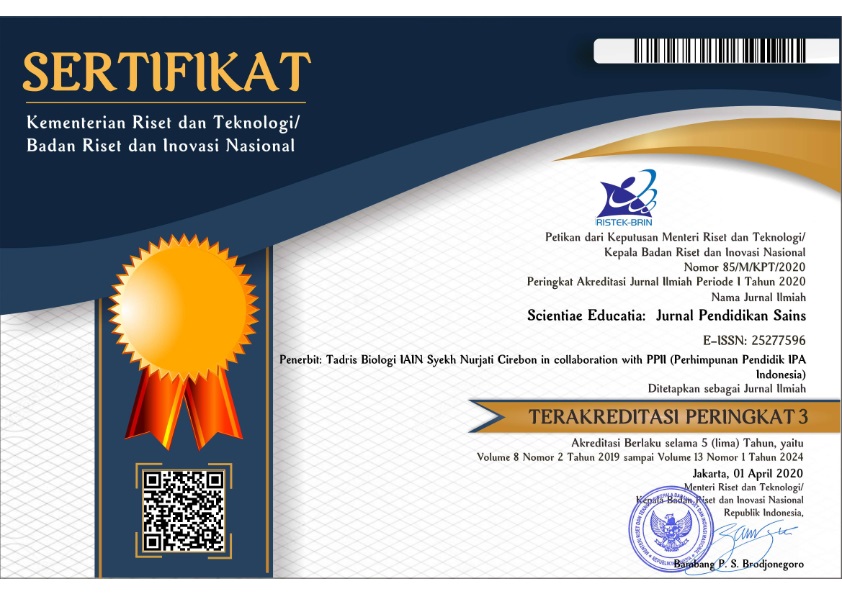Profile of Animal Ecology Field trip: Description of Students’ Identification Skills and Classification Skills
(1) UNIVERSITAS PASUNDAN BANDUNG
(2) Universitas Pendidikan Indonesia
(3) Universitas Pendidikan Indonesia
(*) Corresponding Author
Abstract
This study aimed to describe the activities in the field trip of animal ecology course and describe the identification and classification skills of students at Animal Ecology course. Also, this study describes students responses on-field activities. This study uses a quasi-experimental method using only post-test design. Data analysis using quantitative descriptive analysis techniques. The research subject as many as 30 students to take the test and 40 students are given a questionnaire. The results showed that the CPL course and CPL subjects not relevant to the fact that in both CPL there are some points the use of science and technology, the reality in the learning process technology, it is also supported by student response on the issue. The identification and classification skills of students included in the category sufficient. Analysis of Pearson correlation between the identification and classification skills showed no significant relationship (-.107), it is contrary to some assumptions that states that the ability to identify a basis for classification capability. Thus the results of this study can be used as an input or reference to the development of the program of courses, especially in the subject of animal ecology.
Â
Keywords:Animal ecology fieldtrip; Classification skills; Identification Skills
ebird
Full Text:
PDFReferences
Agostini, N., Gustin, M., von Hardenberg, J., & Panuccio, M. (2016). Wind patterns affect migration flyways and flock size of a soaring bird over sea. Avian Biology Research, 9(3), 159-166. DOI: 10.3184/175815516X14627928448105.
Beri, P. S., Dawande, P. A., Eksambekar, R. A., Gokhale, R. A., & Sonawani, M. S. S. (2016). Migratory Birds Tracking System using RF as Communication Medium and Android Mobile Base Station. International Journal on Recent and Innovation Trends in Computing and Communication, 4(5), 543-545. Available online: https://www.research gate.net/profile/Puneet_Beri2/publication/313646333_Migratory_Birds_Tracking_System_using_RF_as_Communication_Medium_and_Android_Mobile_Base_Station/links/58a15411aca272046aad6af4/Migratory-Birds-Tracking-System-using-RF-as-Communication-Medium-and-Android-Mobile-Base-Station.pdf
Bom, R. A., Bouten, W., Piersma, T., Oosterbeek, K., & van Gils, J. A. (2014). Optimizing acceleration-based ethograms: the use of variable-time versus fixed-time segmentation. Movement Ecology, 2(1), 6. Avaliable online: https://movementecologyjournal .biomedcentral.com/articles/10.1186/2051-3933-2-6
Boss, J., Liedvogel, M., Lundberg, M., Olsson, P., Reischke, N., Naurin, S., ... & Bensch, S. (2016). Gene expression in the brain of a migratory songbird during breeding and migration. Movement ecology, 4(1), 4 DOI: 10.1186/s40462-016-0069-6
Bouten, W., Baaij, E. W., Shamoun-Baranes, J., & Camphuysen, K. C. (2013). A flexible GPS tracking system for studying bird behaviour at multiple scales. Journal of Ornithology, 154(2), 571-580. DOI: 10.1007/s10336-012-0908-1
Bridget J. M., et al. 2016. Ecological causes and consequences of intratropical migration in temperate-breeding migratory birds. The American Naturalist, 188(S1), S28-S40. DOI: 10.1086/687531.
Dodge, S., Bohrer, G., Weinzierl, R., Davidson, S. C., Kays, R.,
Douglas, D., ... & Wikelski, M. (2013). The environmental-data automated track annotation (Env-DATA) system: linking animal tracks with environmental data. Movement Ecology, 1(1), 3. Available online: https://movementecologyjournal.biomedcentral.com/articles/10.1186/2051-3933-1-3.
Fayet, A. L., Freeman, R., Shoji, A., Boyle, D., Kirk, H. L., Dean, B. J., ... & Guilford, T. (2016). Drivers and fitness consequences of dispersive migration in a pelagic seabird. Behavioral Ecology, 27(4), 1061-1072. DOI:10.1093/beheco/arw013. 2016.
Fraenkel, et al. 1993. How to Design and Evaluate Research in Education. Eighth Edition. United States: The McGraw-Hill Companies, Inc.
Freeman, R., Dean, B., Kirk, H., Leonard, K., Phillips, R. A., Perrins, C. M., & Guilford, T. (2013). Predictive ethoinformatics reveals the complex migratory behaviour of a pelagic seabird, the Manx Shearwater. Journal of the Royal Society Interface, 10(84), 20130279. DOI: 10.1098/rsif.2013.0279
Friggens, M. M., et al. 2015. Implications of Climate Change for Bird Conservation in the Southwestern U.S. under Three Alternative Futures. Plos One. DOI:10.1371/journal.pone.0144089.
Galvis, M. A. E., et al. 2013. Flight Performance and Feather Quality: Paying the Price of Overlapping Moult and Breeding in a Tropical Highland Bird. Plos One. 8 (5). e61106. DOI:10.1371/journal.pone.0061106.
Gill, J. A., et al. 2015. Why is timing of bird migration advancing when individuals are not?. The Royal Society Publishing. DOI: 10.1098/rspb.2013.2161
Gilroy, J. J., Gill, J. A., Butchart, S. H., Jones, V. R., & Franco, A. (2016). Migratory diversity predicts population declines in birds. Ecology letters 19(3): 308-317. DOI: 10.1111/ele.12569.
Gohli, et al. 2015. Migration distance is positively associated with sex-linked genetic diversity in passerine birds. Ethology Ecology & Evolution. DOI: 10.1080/03949370.2015.1018954.
Harel, L., et al. 2016. Decision-making by a soaring bird: time, energy and risk considerations at different spatio-temporal scales. The Royal Society Publishing, http://dx.doi.org/10.1098/rstb.2015.0397.
Harms, N. J., et al. 2014. Feather corticosterone reveals effect of moulting conditions in the autumn on subsequent reproductive output and survival in an Arctic migratory bird. The Royal Society Publishing. http://dx.doi.org/10.1098/rspb.2014.2085.
Hobson, K., Van Wilgenburg, S., Dunn, E., Hussell, D., Taylor, P., & Collister, D. (2015). Predicting origins of passerines migrating through Canadian migration monitoring stations using stable-hydrogen isotope analyses of feathers: a new tool for bird conservation. Avian Conservation and Ecology, 10(1). Available online: http://www.ace-eco.org/vol10/iss1/art3/
Horton, T. W., Bierregaard, R. O., Zawar-Reza, P., Holdaway, R. N., & Sagar, P. (2014). Juvenile osprey navigation during trans-oceanic migration. PloS one, 9(12), e114557. DOI:10.1371/journal.pone.0114557
Jumadi 2012. Pemetaan Kompetensi Pedagogik, Profesional, Kepribadian dan Sosial Guru Fisika SMA/MA di Daerah Istimewa Yogyakarta. (Makalah). LPPKM UNY. Tidak diterbitkan. Avalilable online: http://eprints.uny.ac.id/23362/
Kelly, J. F., Horton, K. G., Stepanian, P. M., Beurs, K. M., Fagin, T., Bridge, E. S., & Chilson, P. B. (2016). Novel measures of continentalâ€scale avian migration phenology related to proximate environmental cues. Ecosphere, 7(8). Available online:
http://onlinelibrary.wiley.com/doi/10.1002/ecs2.1434/full
Langham, G. M., Schuetz, J. G., Distler, T., Soykan, C. U., & Wilsey, C. (2015). Conservation status of North American birds in the face of future climate change. PloS one, 10(9), e0135350. DOI:10.1371/journal.pone.0135350.
Laughlin, A. J., et al. 2016. Quantifying non-breeding season occupancy patterns and the timing and drivers of autumn migration for a migratory songbird using Doppler radar. Ecography, 39: 001–008, 2016. DOI: 10.1111/ecog.01988.
Lewis, L. R., Behling, E., Gousse, H., Qian, E., Elphick, C. S., Lamarre, J. F., ... & Goffinet, B. (2014). First evidence of bryophyte diaspores in the plumage of transequatorial migrant birds. PeerJ, 2, e424. DOI: 10.7717/peerj.424.
Mallory, M. L., Little, C. M., Boyd, E. S., Ballard, J., Elliott, K. H., Gilchrist, H. G., ... & Shutler, D. (2015). Leucocyte profiles of Arctic marine birds: correlates of migration and breeding phenology. Conservation physiology, 3(1), cov028. DOI:
1093/conphys/cov028
Mellone, U., et al. 2015. Seasonal differences in migration patterns of a soaring bird in relation to environmental conditions: a multi-scale approach. Behav Ecol Sociobiol 69:75–82. DOI 10.1007/s00265-014-1818-4.
Miller, R. A., et al. 2016. Local and regional weather patterns influencing post-breeding migration counts of soaring birds at the Strait of Gibraltar, Spain. Ibis 158: 106–115. Available online: http://onlinelibrary.wiley.com/doi/10.1111/ibi.12326/full
Nelson, A. R., et al. 2016. Migration patterns of San Francisco Bay Area Hermit Thrushes differ across a fine spatial scale. Animal. Migration, 3:1–13 Available online: http://userwww.sfsu.edu/sehgal/Publications_files/Nelson%20et%20al%20hermit%20thrushes%202016.pdf
Newson, S. E., Moran, N. J., Musgrove, A. J., Pearceâ€Higgins, J. W., Gillings, S., Atkinson, P. W., ... & Baillie, S. R. (2016). Longâ€term changes in the migration phenology of UK breeding birds detected by largeâ€scale citizen science recording schemes. Ibis, 158(3), 481-495. Available online: http://onlinelibrary.wiley.com/doi/10.1111/ibi.12367/full
Orchan, Y., Ovaskainen, O., Bouten, W., & Nathan, R. (2016). Novel Insights into the Map Stage of True Navigation in Nonmigratory Wild Birds (Stone Curlews, Burhinus oedicnemus). The American Naturalist, 187(6), E152-E165. DOI: 10.1086/686054.
Penuela, N. O., et al. 2016. Patterns of bird-window collisions inform mitigation on a university campus. PeerJ. DOI 10.7717/peerj.1652
Resheff, Y. S., et al. 2014. AcceleRater: a web application for supervised learning of behavioral modes from acceleration measurements. Movement Ecology. V. 2 No. 27. p1-7. DOI 10.1186/s40462-014-0027-0.
Robinson, B. S., et al. 2016. A Rose by Any Other Name: Plant Identification Knowledge & Socio-Demographics. Plos One. DOI:10.1371/journal.pone.0156572
Robles, M. R., et al. 2016. Temporal changes in the structure of a plant-frugivore network are influenced by bird migration and fruit availability. PeerJ. DOI: 10.7717/peerj.2048.
Rosin, Z. M., et al. 2016. Constant and seasonal drivers of bird communities in a wind farm: implications for conservation. PeerJ. DOI: 10.7717/peerj.2105.
Rubio, M. S., et al. 2016. Forest birds respond to the spatial pattern of exurban development in the Mid-Atlantic region, USA. PeerJ. DOI: 10.7717/peerj.2039.
Rushing, C. S. et al. 2016. Quantifying drivers of population dynamics for a migratory bird throughout the annual cycle. The Royal Society Publishing. DOI: /10.1098/rspb.2015.2846.
Saino, N., et al. 2015. Polymorphism at the Clock gene predicts phenology of long-distance migration in birds. Molecular Ecology, 24: 1758–1773. DOI: 10.1111/mec.13159. 2015.
Schuld, C., et al. 2015. International standards for neurological classification of spinal cord injury: classification skills of clinicians versus computational algorithms. Spinal Cord. (2015) 53, 324–331 Avaliable online: https://www.nature.com/articles/sc2014221
Sjo’berg, S., et al. 2015. Nocturnal migratory songbirds adjust their travelling direction aloft: evidence from a radiotelemetry and radar study. The Royal Society Publishing. DOI: 10.1098/rsbl.2015.0337
Sorte, F. A. L., Fink, D., Hochachka, W. M., DeLong, J. P., & Kelling, S. (2013). Populationâ€level scaling of avian migration speed with body size and migration distance for powered fliers. Ecology, 94(8), 1839-1847. Available online: http://onlinelibrary.wiley.com/doi/10.1890/12-1768.1/full
La Sorte, F. A., Fink, D., Hochachka, W. M., Farnsworth, A., Rodewald, A. D., Rosenberg, K. V., ... & Kelling, S. (2014). The role of atmospheric conditions in the seasonal dynamics of North American migration flyways. Journal of Biogeography, 41(9), 1685-1696. DOI:10.1111/jbi.12328.
Sorte, F. A. L., et al. 2016. Spring phenology of ecological productivity contributes to the use of looped migration strategies by birds. The Royal Society Publishing, DOI: 10.1098/rspb.2014.0984.
Soto, R., Crawford, B., Almonacid, B., & Paredes, F. (2016). Efficient parallel sorting for migrating birds optimization when solving machine-part cell formation problems. Scientific Programming, 2016:1-39 DOI: 10.1155/2016/9402503.
Stutchbury, B. J., Fraser, K. C., Silverio, C., Kramer, P., Aeppli, B., Mickle, N., ... & Mejeur, J. (2016). Tracking mated pairs in a long-distance migratory songbird: migration schedules are not synchronized within pairs. Animal Behaviour, 114, 63-68. Available online: http://www.sciencedirect.com/science/article/pii/S0003347216000191
Supp, S. R., Sorte, F. A. L., Cormier, T. A., Lim, M. C., Powers, D. R., Wethington, S. M., ... & Graham, C. H. (2015). Citizenâ€science data provides new insight into annual and seasonal variation in migration patterns. Ecosphere, 6(1), 1-19. Available online: http://onlinelibrary.wiley.com/doi/10.1890/ES14-00290.1/full
Surasinghe, T., & Courter, J. (2012). Using eBird to Integrate Citizen Science into an Undergraduate Ecology Field Laboratory. Bioscene: Journal of College Biology Teaching, 38(2), 16-20. Available online: https://eric.ed.gov/?id=EJ1002149
Thomas, R. L., & Fellowes, M. D. (2017). Effectiveness of mobile apps in teaching field-based identification skills. Journal of Biological Education, 51(2), 136-143. DOI: 10.1080/00219266.2016.1177573
Vágási, C. I., Pap, P. L., Vincze, O., Osváth, G., Erritzøe, J., & Møller, A. P. (2016). Morphological adaptations to migration in birds. Evolutionary Biology, 43(1), 48-59. DOI: 10.1007/s11692-015-9349-0.
Weimerskirch, H., et al. 2012. Changes in Wind Pattern Alter Albatross Distribution and Life-History Traits. Science, V. 335, 211 (2012), DOI: 10.1126/science.1210270.
Winger, B. M., Barker, F. K., & Ree, R. H. (2014). Temperate origins of long-distance seasonal migration in New World songbirds. Proceedings of the National Academy of Sciences, 111(33), 12115-12120. Available online: http://www.pnas.org /content/111/33/12115.short
Zogaris, S., et al. 2016. Coastal zone habitat-use by birds in Qatar: Insights from a rapid assessment method during spring migration. Tropical Conservation Science, Vol. 9 (2): 658-676. Available online: http://journals.sagepub.com/ doi/abs/10.1177/194008291600900207
Zuckerberg, B., et al. 2016. Novel seasonal land cover associations for eastern North American forest birds identified through dynamic species distribution modeling. Diversity and Distributions, (Diversity Distrib.) 22: 717–730. DOI: 10.1111/ddi.12428.
DOI: 10.24235/sc.educatia.v6i2.1286
Article Metrics
Abstract view : 972 timesPDF - 597 times
Refbacks
- There are currently no refbacks.
Scientiae Educatia: Jurnal Pendidikan Sains indexed by:

This work is licensed under a Creative Commons Attribution 4.0 International License.
Stat Counter (Link)



1.png)












